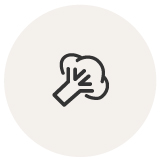


More fruits and vegetables
While there are many reasons to adopt meatless dishes such as concern for animal welfare or health benefits, sustainability is also a big motivator.
Beef and lamb are some of the foods with the highest environmental impact, while fruits such as apples, oranges or tomatoes and vegetables such as peas or corn are some of the products that carry the least greenhouse gas.
It is estimated that food production is behind a quarter of the greenhouse gas emissions we release into the atmosphere each year. A gesture as simple as promoting more fruit and vegetable options will undoubtedly have a major impact on creating a sustainable menu.

Reusable cutlery
On average, 400 million tons of plastic are produced annually, and it is estimated that, if trends remain unchanged, the figure will reach 1.1 billion by 2050.
Using table linen and tableware not only improves the setting, but also reduces the environmental impact.
In addition, managing organic waste through composting is an effective way to close the food life cycle. By converting organic waste into compost, it can be used to fertilize soils and improve soil quality. This not only reduces the amount of waste sent to landfills, but also contributes to the production of natural nutrients for the soil.
Education and awareness are key in this regard. Informing customers, participants, and staff about the importance of waste separation and how their actions contribute to sustainability can have a significant impact.
However, we should not forget that recycling should always be the second option. Not generating waste or reusing it (in the case of glass, for example) will always be more sustainable than subjecting materials to a recycling process.


Proximity and seasonal products
Opting for local products avoids food having to travel long distances to reach our plates, while boosting local commerce.
Consuming fresh and seasonal products also prevents them from having to be kept in refrigerated chambers for long periods of time. In this way, we have tastier and healthier products.

Cuisine that makes the most of the season
A caterer who bets on the kitchen of use is, undoubtedly, a caterer who seeks sustainability. This type of cuisine is based on the premise of making the most of all food, even leftovers, to create new dishes and recipes.
Back to the cooking that our grandfathers and grandmothers used to do, where nothing was thrown away.

Sustainable lighting and decoration
The elements that shape a sustainable menu and catering are not limited to food and cutlery.
Implementing sustainable lighting systems and decorations, as well as using venues in natural settings, also add up to creating an event that is more responsible with our environment and our planet.
The results are always positive: more and more people value events where taking care of our planet is not an option, but a priority.

Nothing is thrown away
It is estimated that 17% of all food produced worldwide is thrown away. One of the great advantages of the “cook-to-use” kitchen is to reduce this food waste. A problem that has a major social, economic and environmental impact.
Using food to create new dishes is not the only solution to this problem. Donating them to NGOs and other social entities can make an event more environmentally and, above all, socially sustainable.
© Copyright GAU Catering 2023. Todos los derechos reservados.

WE LOVE COOKIES
Nuestras favoritas son las de chocolate con nueces, pero intentamos que tu experiencia sea lo mejor posible.